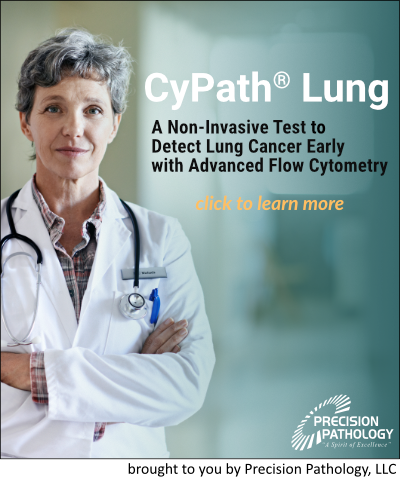Research at Los Alamos National Laboratory and St Mary’s Hospital
January 15, 2015
St. Mary’s Hospital and the Isotope and Nuclear Chemistry Division of the Medical Radioisotopes Research Program at Los Alamos National Laboratory conducted preliminary studies from 1988 to 1992 researching porphyrins that led to more specific research into 10,15,20-tetrakis (4-carboxyphenyl) porphine (TCPP) and its ability to detect lung cancer by labeling cancer cells in sputum.
Researchers at Los Alamos National Laboratory conducted a series of studies that would identify a specific porphyrin for use in the diagnosis of lung cancer. The studies are summarized The compound meso-Tetra (4-carboxyphenyl) porphyrin (TCPP) was found to be particularly well-suited for lung cancer detection, because it contains carboxyl groups that become electrostatically neutral in the slightly acidic sputum-labeling environment, significantly improving its uptake into lipophilic cell membranes.
Porphyrin’s localization in (abnormal) lung cells from uranium miners
2 patients: One lung cancer patient and one person with COPD but no lung cancer
D. Cole; D. Moody; L. Ellinwood; M. Klein
Fluorescence was seen in every neoplastic (abnormal) cell identified in sputum samples, indicating high uptake of the bio-label. The fluorescent intensity (brightness) of the cells was also greater in samples labeled with the porphyrin used by bioAffinity Technologies for cancer diagnosis and drug delivery as compared with samples labeled with other porphyrins.
Testing the ability to diagnose lung cancer in different patients in a blind study with different types of lung cancers
12 patients: Eight lung cancer / four non-cancer patients
D. Cole; D. Moody; L. Ellinwood; M. Klein
Sputum samples from cancer patients stained with the test showed the highest fluorescence with the exception of one patient who was thought not to have lung cancer but displayed high fluorescent cells in his sample. This person was re-evaluated and found to have lung cancer. With this finding, the study resulted in 100% accuracy.
Testing in human squamous lung cancer cell line and ability of cells to be detected by automated imaging
Lung Cancer Cell Lines
D. Cole; D. Moody; L. Ellinwood; M. Klein
Squamous carcinoma (cancer) cells grown in culture stained with the bio-label could easily be detected with flow cytometry, an automated imaging system that measures the fluorescence of individual cells. Researchers determined that the autofluorescence of control cells (cells not exposed to the bio-label) was negligible.
Evaluation of the test on human small cell lung cancer and normal human lung epithelial cell lines
Cell Lines: 21 cancer samples and 4 non-cancer samples
D. Cole, PhD, Los Alamos National Laboratory (LANL); D. Moody, PhD, LANL; L. Ellinwood, MD, PhD, St. Mary’s Hospital; M. Klein, MD, St. Mary’s Hospital
100% of cancer samples contained high fluorescing cells as a result of high uptake of the bio-label. Concentration in normal and abnormal (non-cancer) lung cells was many times lower than cancer cells.

